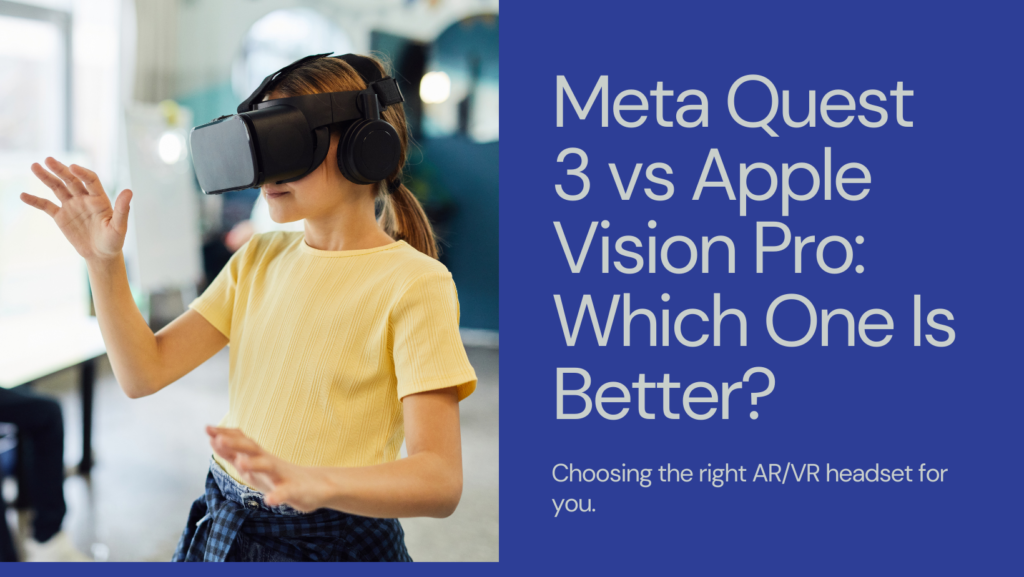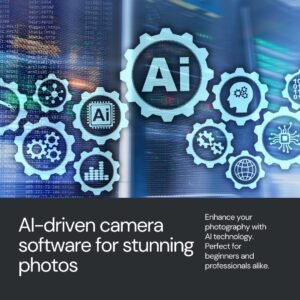
The virtual reality (VR) landscape is heating up, and the competition between Meta Quest, previously known as Oculus, and Apple is poised to redefine the immersive digital experience for millions of users. As Meta Quest introduces its third iteration, and Apple unveils its long-anticipated contender, Vision Pro, enthusiasts and techies alike are eager to discern which could be their next door to the metaverse.
In this comprehensive comparison between Meta Quest 3 vs Apple Vision Pro,, we’ll break down the Meta Quest 3 and Apple Vision Pro across design, hardware, software ecosystems, user experience, pricing, and much more.
Introduction
The concept of VR technology has graduated from the realm of science fiction to consumer reality, offering a whole new dimension of entertainment and productivity. As industries leverage VR for applications as varied as immersive gaming, augmented design, and remote work collaboration, the stakes have never been higher for the hardware and platforms that power these experiences.
Meta Quest 3 and Apple Vision Pro represent the cutting edge of this technology, each with its own unique vision for what VR can achieve. From untethered all-in-one experiences to the promise of seamless integration with Apple’s ecosystem, the future of VR is not only bright but brimming with potential.
Design and Hardware
When it comes to VR headsets, design isn’t just about looks. It influences comfort, balance, and the overall immersive experience. The Meta Quest 3 and Apple Vision Pro have distinct design philosophies that cater to different user needs.
Meta Quest 3
Size and Weight
The Meta Quest 3 follows the footsteps of its predecessors, retaining a lightweight and approachable form factor. The balance between size and weight sets a comfortable standard for extended wear, crucial for immersive gaming sessions or long stretches of productivity in VR.
Display Technology
Offering a 120Hz display with adjustable refresh rates, the Meta Quest 3 promises smooth and lifelike visuals. Its LCD panel boasts improved color accuracy and reduced screen-door effect, a common criticism of early VR displays.
Processing Power
Housing an advanced Qualcomm Snapdragon XR2 chipset, Meta Quest 3 is no slouch in performance. This enables complex VR applications and helps maintain a high level of graphics quality without the need for a separate console or PC.
Battery Life
Battery life on the Meta Quest 3 is a considerable improvement, offering up to 4-5 hours of playtime. Fast charging capabilities mean you can jump back into the action swiftly after a quick top-up.
Apple Vision Pro
Size and Weight
Apple’s Vision Pro enters the ring with a distinct focus on sleek aesthetics and ergonomic stability. Its design language reflects Apple’s commitment to minimalism and a balance of glass and aluminum that’s emblematic of their product line.
Display Technology
With an industry-leading microLED display, the Vision Pro offers unrivaled picture quality and vibrant HDR visuals that pop with detail. Its variable refresh rate technology ensures the performance is tailored to the needs of the content, maximizing battery life.
Processing Power and Performance
The Vision Pro is powered by Apple’s custom silicon, ensuring exceptional performance that even Intel and AMD’s chips are starting to take notice of. This sets a high bar for VR experiences on the Vision Pro and hints at its potential for more AI-driven applications down the line.
Battery Life
Apple’s efficiency and power management prowess are evident in the Vision Pro’s impressive battery life, boasting up to 8 hours on a single charge. Quick Charge and wireless charging capabilities serve to keep users immersed with minimal downtime.
Software and Content Ecosystem
Hardware may grab the headlines, but it’s the software that truly unlocks a VR device’s potential. A robust ecosystem of apps and games, an intuitive user interface, and a supportive development community can make or break a VR platform’s long-term success.
Meta Quest 3
Operating System and Interface
Powered by Meta’s proprietary software, Meta Quest 3 benefits from an interface designed from the ground up for VR interactions. Its menu system and intuitive controls make navigating the device’s settings and library a breeze.
Available Apps and Games
The Meta Quest ecosystem boasts a vast array of games and applications available through the Meta Store. From established franchises to indie darlings, it offers a balanced mix of entertainment and utility, with a rapidly expanding library of experiences.
Developer Support
Meta Quest prioritizes accessibility and encourages a broad range of developers to create content for its platform. This inclusive approach leads to a diverse range of apps and games, cementing Meta as a frontrunner in the VR space.
Apple Vision Pro
Operating System and Interface
Utilizing an adapted version of iOS with a VR-centric interface, the Vision Pro promises a familiar and seamless user experience for Apple enthusiasts. Integration with existing Apple devices and services could offer a unique advantage in the ease of use and interoperability.
Available Apps and Games
Though launching with a more modest library, the Vision Pro’s entry into the VR market hints at an exciting future with potential cross-functionality with existing Mac and iOS apps. Early adopters may find their favorite applications optimized for the Vision Pro, enhancing the overall ecosystem.
Developer Support
Apple’s platform is synonymous with a strong developer community, and the Vision Pro is no exception. With tools and support from Apple, developers can leverage their existing expertise to create groundbreaking VR content, potentially shifting the paradigm of what’s possible in VR.
User Experience: Meta Quest 3 vs Apple Vision Pro
We all agree that the user experience covers various aspects, from the first-time setup to daily use. The feel of the device, its operational efficiency, and its capacity to support social interactions play significant roles in shaping the virtual reality experience for users.
Meta Quest 3
Setup Process and Ease of Use
Meta Quest 3 continues the tradition of minimal setup, offering a straightforward process that gets users into the action quickly. Its standalone nature eliminates the need for additional hardware, simplifying the user experience.
Immersive Experience Quality
With precise inside-out tracking and minimal latency, the Meta Quest 3 provides a high-quality VR experience. Its 6DOF (Six Degrees of Freedom) ensures users can move naturally within virtual environments, enhancing the sense of immersion.
Comfort and Ergonomics
The Quest 3 has improved ergonomic adjustments, with customizable straps and a more balanced design aimed at reducing fatigue during extended play. Comfort is a priority, especially considering the physicality of many VR experiences.
Social and Multiplayer Features
The Meta Quest 3’s social capabilities, including Meta Quest Home and Horizon Worlds, promote a sense of community in VR. Multiplayer games and exclusive events provide shared experiences that can bridge physical distances.
Apple Vision Pro
Setup Process and Ease of Use
Leveraging Apple’s renowned simplicity, the setup process for the Vision Pro is expected to be intuitive and streamlined. Its integration with other Apple devices might allow for a setup that’s as simple as pairing AirPods.
Immersive Experience Quality
With a focus on high-quality visuals and an advanced headset tracking system, the Vision Pro is designed to offer an immersion that’s both visually stunning and captivating. The meticulous consideration given to every facet of the user experience ensures a premium interaction for its users.
Comfort and Ergonomics
Apple’s detailed design strategy for the Vision Pro emphasizes comfort through adjustable features and thoughtfully chosen materials, catering to a diverse array of head sizes and shapes for optimal wearability.
Social and Multiplayer Features
The Vision Pro’s social features could potentially take advantage of Apple’s existing communication platforms, offering seamless integration with Messages and FaceTime for shared VR experiences.
Pricing and Availability
When deciding on a VR headset, the cost and accessibility are important factors. This section provides insight into the economic implications of choosing Meta Quest 3 or Apple Vision Pro.
Meta Quest 3
Cost Comparison
The Meta Quest 3 is priced competitively within the standalone VR market, offering a significant value proposition given its feature set. Various bundles are available, providing options that cater to different budgets and needs.
Included Accessories and Necessary Add-Ons
The Meta Quest 3 is priced competitively within the standalone VR market, offering a significant value proposition given its feature set. Various bundles are available, providing options that cater to different budgets and needs.
Availability in Different Regions
Meta Quest 3 is available in a growing number of regions, with an expanding global footprint. However, availability can vary, and prospective buyers should check for local information before making a purchase.
Apple Vision Pro
Cost Comparison
The Vision Pro may enter the market at a premium compared to other standalone VR headsets, reflecting the quality and performance associated with Apple’s brand. The pricing strategy will play a critical role in its adoption by consumers and businesses alike.
Included Accessories and Necessary Add-Ons
Apple’s accessory ecosystem is known for its completeness, and the Vision Pro may come with all the essentials needed for a complete VR setup. That said, high-quality add-ons tailored to optimize the experience could be available at an additional cost.
Availability in Different Regions
Apple’s widespread global presence suggests the Vision Pro may be available in a multitude of regions from launch. However, like Meta Quest 3, local availability and support will be important considerations for prospective buyers.
Pros and Cons
To further encapsulate the comparison, we’ll outline the standout benefits and limitations of each device to offer a clear picture of their respective strengths and challenges.
Vision Pro has a price tag of $3,499, offering superior design, micro-OLED displays for 4K resolution. Whereas, the Meta Quest 3 is more affordable at $499-$649, targeting VR enthusiasts and gamers with LCD display, and a strong library of apps and games. While Quest 3 is more consumer-centric, the Vision Pro aims to merge an iPhone, MacBook, and Apple TV into one high-end VR experience.
Meta Quest 3
Advantages
- Proven track record in the VR market
- Affordable entry point for high-quality standalone VR
- Broad developer and consumer adoption
Disadvantages
- Limited by onboard processing power
- Tether-free design may limit hardware upgrades
- Heavier reliance on Meta’s content ecosystem
Apple Vision Pro
Advantages
- Apple’s brand prestige and legacy of innovation
- Potential for ecosystem integration with existing Apple devices
- Premium, high-performance hardware components
Disadvantages
- Likely higher price point compared to other VR headsets
- Initial content library may be less extensive
- Uncertainty around compatibility with non-Apple ecosystems
Conclusion
The decision between Meta Quest 3 and Apple Vision Pro isn’t just about the specifications; it’s about the kind of experience you want to have in VR. For those looking for a well-established platform with a robust content library and affordability, the Meta Quest 3 stands as a compelling choice.
On the other hand, if you’re deeply invested in Apple’s ecosystem, prioritize premium hardware, and wish to be on the ground floor as Apple ventures into VR, the Vision Pro may align more closely with your needs and expectations.
Ultimately, both devices herald a new era in VR technology, and the competition they fuel is bound to yield higher standards and new innovations. As the metaverse draws closer, the choice in VR headset is set to become more personal and more pivotal to how we interact with the digital future. Whether your allegiance lies with the social media giant or the tech behemoth, one thing is certain—VR has never been more exciting, or more within reach.
Please Share
Frequently Asked Questions (FAQ)
The choice between Apple Vision Pro and Meta Quest 3 largely depends on your budget and intended use. The Vision Pro is a premium device with a price tag of $3,499, offering superior design, micro-OLED displays for 4K resolution per eye, and a focus on a work-oriented experience. In contrast, the Meta Quest 3 is more affordable at $499-$649, targeting VR enthusiasts and gamers with a Snapdragon XR2 Gen 2 SoC, LCD display, and a strong library of apps and games. While Quest 3 is more consumer-centric, the Vision Pro aims to merge an iPhone, MacBook, and Apple TV into one high-end VR experience.
The Meta Quest 3 does not offer a 4K resolution per eye. Its display resolution is 2064 × 2208 per eye, which is high-definition but falls short of 4K resolution. The headset focuses on delivering a refined VR experience with features like hand tracking, PC compatibility, and a 120Hz refresh rate, making it suitable for VR enthusiasts and gamers.
Related Posts

Artificial Intelligence Algorithms
Artificial Intelligence algorithms are the backbone of modern intelligent systems, enabling machines to perform tasks that typically require human intelligence.

Innovations in AI for Education
Discover how Innovations in AI (Artificial Intelligence) is transforming education with personalized learning paths, intelligent tutoring systems, and predictive analytics for enhanced learning experiences.

Best AI Virtural Camera Software
Discover the best AI virtual camera software enhancing remote work with features like background replacement, real-time effects, and advanced facial tracking. Explore their benefits and unique selling points in our latest blog.
